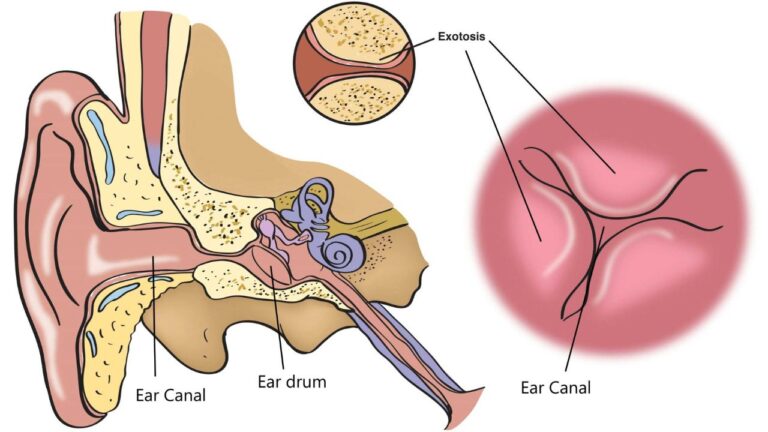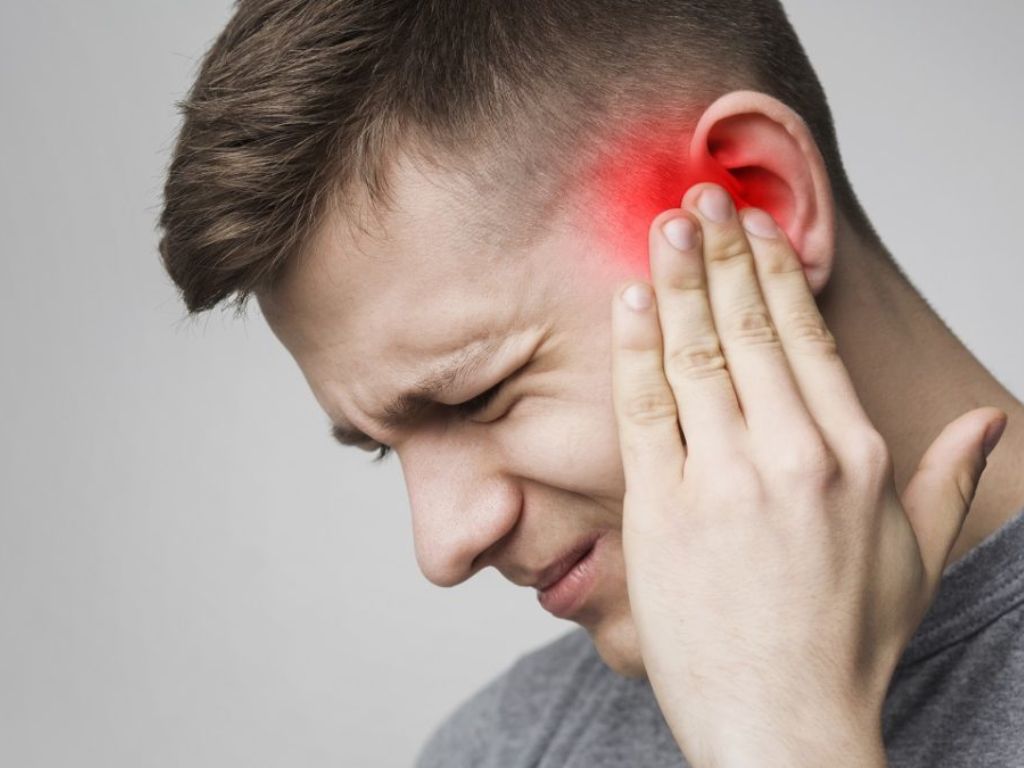Picture this: the sun shining, waves crashing, and the amazing feeling of riding a surfboard.
But amidst the thrill, a lesser-known condition can affect those who spend significant time in the water – Surfer’s Ear.
Surfer’s Ear, also known as Exostosis, is a common condition that affects individuals whose ears are regularly exposed to cold water and wind. It causes bone growth in the ear canal, leading to ear infections or hearing impairment.
Understanding Surfer’s Ear is crucial for anyone engaged in water sports. Recognizing the symptoms will lead to early diagnosis and timely treatment. On the contrary, an untreated Surfer’s Ear can lead to various complications, impacting your surfing performance and overall health.
What are the symptoms of Surfer’s ear?
One of the primary symptoms of Surfer’s Ear is the narrowing of the ear canal. As exostoses develop, they gradually reduce the available space within the ear canal, leading to a feeling of fullness or blockage.
Hearing loss is another significant symptom associated with Surfer’s Ear. As the bony growths obstruct the ear canal, sound waves struggle to pass through effectively, reducing hearing capabilities.
You’re likely to notice a gradual decline in your ability to hear clearly, especially in situations where there is background noise. Recurring ear infections are also common among those with Surfer’s Ear because exostoses create an environment where moisture and debris become trapped.

If you experience any of these symptoms, seeking medical attention for a professional examination and accurate diagnosis is crucial. A healthcare provider, typically an ear, nose, and throat (ENT) specialist, can perform an otoscopy to confirm.
Safety Tip: Early diagnosis is key to managing Surfer’s Ear effectively.
What are the complications and risks of Surfer’s Ear?
Common risks and problems associated with Surfer’s Ear include
- recurrent ear infections,
- hearing loss,
- ear pain and discomfort,
- impacted earwax,
- tinnitus,
- balance issues,
- increased risk of injuries, and
- impact on performance.
How do you treat Surfer’s Ear?
When treating Surfer’s Ear, two options are available depending on the severity of the condition and individual needs.
1. Non-surgical Treatment Options
For mild cases of Surfer’s Ear, non-surgical interventions may be sufficient to manage the condition.
One such approach is the use of ear drops. These drops contain ingredients that help soften and remove excess earwax, reducing the obstruction caused by exostoses.
2. Surgical Interventions
Surgical interventions may be considered in more advanced cases. The primary surgical procedure for Surfer’s Ear is canaloplasty, which involves removing the bony growths from the ear canal.
How can you prevent Surfer’s Ear?
Prevention is key when managing any condition. In this case, the best way would be to wear earplugs when in/on the water. These earplugs create a barrier between the ear canal and the water, preventing direct exposure to cold water and wind.

It’s also important to maintain proper ear care and hygiene. After surfing or participating in water sports, it’s advisable to dry the ears thoroughly using a clean towel or a gentle stream of warm air.
Regular check-ups with an ENT specialist are vital for early detection and intervention. Professionals can assess the condition of the ear canal, monitor the growth of exostoses, and provide personalized recommendations based on your individual needs.
Rehabilitation and Return to Surfing
After undergoing treatment for Surfer’s Ear, rehabilitation is necessary to ensure proper healing and a safe return to water sports activities. The duration of rehabilitation may vary depending on the individual and the type of treatment received.
1. Healing Time
The healing time following surgical intervention for Surfer’s Ear can range from several weeks to a few months.
It’s essential to follow the postoperative instructions the healthcare professional provides, including keeping the ear dry and avoiding strenuous activities that may impact the healing process. Adhering to the prescribed healing period is crucial for the long-term success of the treatment.
2. Follow-Up Appointments
Regular follow-up appointments with the ENT specialist are vital to monitor the healing progress and assess the treatment outcomes. These appointments allow the healthcare professional to examine the ear canal, address any concerns, and recommend a safe return to surfing.
3. Gradual Return to Surfing
Returning to surfing after treatment for Surfer’s Ear should be done gradually and with caution. It’s advisable to start with small waves and gentle conditions to allow the body to readjust to the water environment.
Wearing specialized ear protection, such as custom-fitted earplugs or ear molds, can provide an added layer of protection and prevent the reoccurrence of Surfer’s Ear.
Expert QnA
Q. Can Surfer's Ear affect my surfing performance?
Surfer’s Ear can impact surfing performance. The narrowing of the ear canal due to bony growths can affect the ability to hear and maintain balance in the water. It also gets challenging to wear earplugs after Exostosis.
Q. Can Surfer's Ear be prevented?
Surfer’s Ear can be prevented by preventive measures such as earplugs or specialized ear protection limiting water exposure. Proper ear care, including drying ears thoroughly after water activities, can also help reduce the risk of developing a Surfer’s Ear.
Q. How long does recovering from Surfer's Ear surgery take?
The recovery period following Surfer’s Ear surgery can vary depending on the individual and the extent of the procedure. The ear typically takes several weeks to a few months to heal completely. It’s important to follow post-operative instructions, avoid water activities, and attend scheduled follow-up appointments during this time.
Q. Can Surfer's Ear come back after treatment?
While the surgical removal of bony growths is generally effective, there is a possibility of recurrence in some cases. To minimize the risk of recurrence, it’s crucial to follow preventive measures, such as wearing ear protection and maintaining proper ear hygiene, even after treatment.
Q. What is the difference between a Swimmer's Ear and a Surfer's Ear?
Swimmer’s Ear is an infection caused by water in the ear canal after swimming, while Surfer’s Ear involves the growth of bone spurs due to exposure to cold water and wind. Swimmer’s Ear causes pain, itching, and redness, while Surfer’s Ear leads to narrowed ear canals, hearing loss, and recurring infections.
Q. How long does Surfer’s Ear last?
The duration of a Surfer’s Ear can vary depending on the severity of the condition and the chosen treatment option. In mild cases with minimal bony growth and no significant symptoms, it may not require immediate treatment and can remain stable for an extended period.
However, medical intervention may be necessary if the condition progresses and causes symptoms such as ear infections or hearing loss. Treatment and recovery can vary, ranging from a few weeks to several months.




